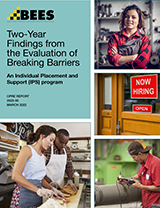Two-Year Findings from the Evaluation of Breaking Barriers
An Individual Placement and Support (IPS) Program

 Introduction
Introduction
Breaking Barriers was a San Diego-based program that provided employment services to individuals with low incomes and disabilities who were looking for work. The program used the Individual Placement and Support (IPS) model. There is extensive evidence of IPS’s success for people with serious mental illness, the group for which the intervention was originally designed. Breaking Barriers presented an opportunity to test the model with a different group: people with a range of disabilities and health conditions.
Breaking Barriers operated from January 2016 through mid-2018 in four San Diego locations. Some of the key features of the program included career counseling to establish clients’ goals and interests, job search assistance, systematic job development with local employers, personalized benefits counseling, referrals to supportive services, and follow-along support after job placement. A randomized controlled trial with over 1,000 participants was used to assess Breaking Barriers’ impact on outcomes such as employment, earnings, and health. Eligible individuals were assigned at random to a program group and offered Breaking Barriers services, or to a control group that did not receive those services and was referred to other publicly available supports. An evaluation of the program, conducted by MDRC in partnership with MEF Associates, included an implementation study, a cost analysis, and an impact analysis based on a 15-month follow-up survey. A 2019 report detailed findings from that evaluation.
This report summarizes findings from that earlier report and presents new impact findings based on administrative records from the National Directory of New Hires. These records include information on study participants’ quarterly employment and earnings over an extended, two-year follow-up period.
Key Findings and Highlights
- Breaking Barriers increased earnings by almost $4,000 over the two-year follow-up period, based on the new analysis conducted for this report, using administrative records. This stands in contrast to the analysis from the 2019 report based on survey data, which did not find any impacts on employment or earnings outcomes.
- Breaking Barriers connected people in the program group to employment and increased earnings for this group earlier in the follow-up period compared with those in the control group, who did not have access to the program services.
- The Breaking Barriers evaluation shows the program is a promising way to connect job seekers to work and builds further evidence that IPS can be successful among those with a range of disabilities and health conditions.







